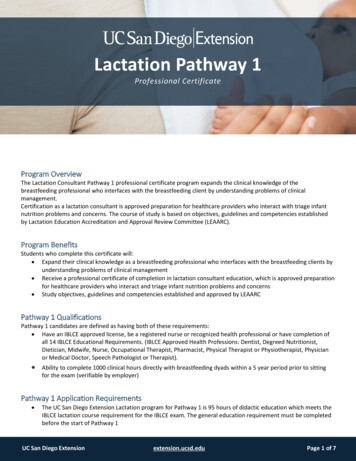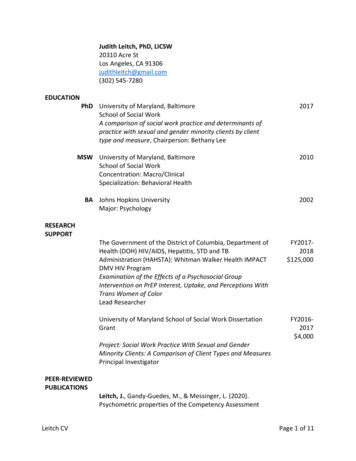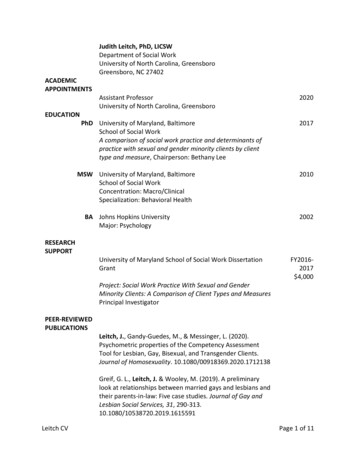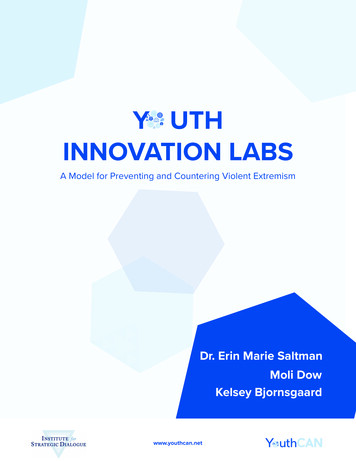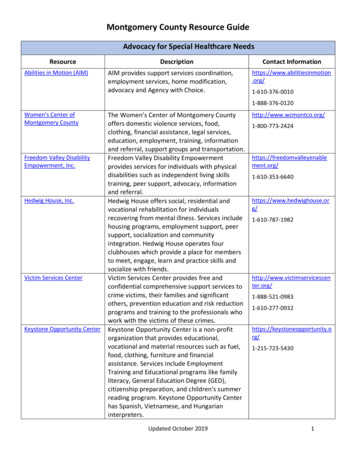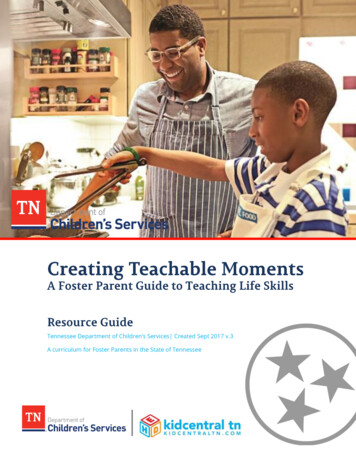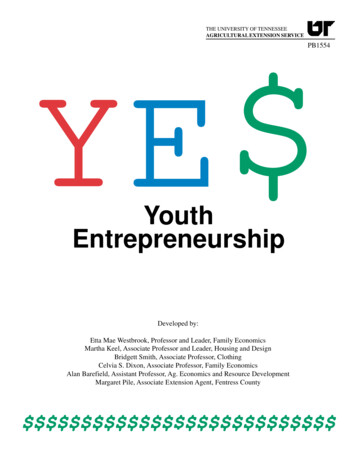
Transcription
THE UNIVERSITY OF TENNESSEEAGRICULTURAL EXTENSION SERVICEPB1554Y E YouthEntrepreneurshipDeveloped by:Etta Mae Westbrook, Professor and Leader, Family EconomicsMartha Keel, Associate Professor and Leader, Housing and DesignBridgett Smith, Associate Professor, ClothingCelvia S. Dixon, Associate Professor, Family EconomicsAlan Barefield, Assistant Professor, Ag. Economics and Resource DevelopmentMargaret Pile, Associate Extension Agent, Fentress County 1
TABLE OF CONTENTSIntroduction3YE and the 4-H Projects and Activities6Lesson Plans, Student Handouts and Overhead MastersWhat is an Entrepreneur?Is Entrepreneurship for You?Business Ideas that WorkInvestigating Local BusinessesYour Business Plan: The Starting PlaceMake It LegalOperating Your BusinessPrice It RightCash Flow and Other Essentials73348597183101118139Resources147Student Evaluation Form157 2THE UNIVERSITY OF TENNESSEEAGRICULTURAL EXTENSION SERVICE
YOUTH ENTREPRENEURSINTRODUCTIONThe YE curriculum has been designed for use in three ways to strengthen 4-H programming. Extensionagents may use the curriculum to: Teach lessons in the classroom as a visiting educator or co-teach with the classroom teacher. Conduct workshops for educators who would like to have a copy of the curriculum and teach the materialsthemselves. Train volunteer leaders to conduct entrepreneurial activities with members enrolled in 4-H projects. TheYE curriculum is designed as an enrichment activity to be integrated with or to supplement existingprojects.The YE program has been developed to support selected TCAP goals, objectives and concepts. Thefollowing is only a sampling of the YE program’s relationship to the TCAP framework.GENERAL EDUCATION GOALSFundamentals of Learning and Communication Comprehend ideas through reading and listening Communicate ideas through writing and reading Understand fundamental mathematical concepts, principles and skills Use scientific problem solving methods such as research, analysis and evaluationSkills and Attitudes which Facilitate Learning Abstract thinking Independent studying and learning Objective observation Opportunities to make choices and mistakes under supportive conditionsSatisfactory Relationships with Other Persons Competence in interpersonal and group relationshipsResponsible Citizenship An understanding of the merits of the free enterprise systemCareer Information and Economic Competence The acquisition of a sufficient amount of career information with which to decide The relationship between aptitudes, interests and one’s occupation Knowledge, abilities and skills for entry into the world of work upon completion of chosen levelsof education Have sufficient information to realize his or her life goals 3THE UNIVERSITY OF TENNESSEEAGRICULTURAL EXTENSION SERVICE
OBJECTIVES AND CONCEPTSLanguage ArtsThe student will understand: location of reference materials how to use different sources of information basic thinking skills the synthesis of information methods of inquiry summarizing and synthesizing in readingMathThe student will: master skills and concepts necessary for mathematics literacy in a changing technological society understand the basic concepts of arithmetic for application to daily livingSocial StudiesThe student will: acquire career information and economic competence become a responsible, contributing, informed member of the family, the local community, the nation andthe world develop skills in oral and written communications, information gathering, critical thinking and problemsolving be equipped to cope with change learn to appreciate others’ ideasBusiness EducationThe student will: understand legal rights and responsibilities related to various personal and business practices understand the knowledge required for effective entry-level management of business understand the responsibilities of each type of business ownership understand the factors that can affect a pricing policy understand the importance of planning a total advertising campaign grasp the importance of planning understand the steps of problem solving appreciate the need for continuing research manage personal business affairs competently and independently furnish students with an understanding of the “world of work” as it applies to technological innovationsand business operations facilitate and encourage leadership and personal development manage work and leisure time develop skills and knowledge to compete successfully for jobs in business recognize the need for continuous study and growth as an individual through post-secondary education inbusiness develop desirable work habits and attitudes in realizing the value of work 4THE UNIVERSITY OF TENNESSEEAGRICULTURAL EXTENSION SERVICE
Marketing EducationThis curriculum will meet the needs of persons who have entered or are preparing to enter an occupation orentrepreneurial venture requiring competencies in marketing.United States HistoryThis curriculum will enable the student to understand the role entrepreneurs have played in United Stateshistory.Vocational Home EconomicsThis curriculum will: give consideration to economic, social and cultural conditions and needs of families contribute to the employability of youth as they assume the roles of homemaker/wage earnerLanguage ArtsThese curricula will enable the student to: understand basic thinking skills understand how decisions and habits can affect well-being develop creative thinking skillsEconomicsThe student will understand that: the free enterprise system is based on the premise of a free market the focus of economic activity lies in the production of goods and services for humanconsumptionVocational AgricultureThe student will develop: competence in at least one agricultural work area (entrepreneurship and employment) through classroom,laboratory, shop and supervised occupational experience programs including record keeping andcooperative education problem solving skillsHealth OccupationsThe student will acquire career information and economic competence 5THE UNIVERSITY OF TENNESSEEAGRICULTURAL EXTENSION SERVICE
YE and the 4-H Projectsand ActivitiesYE is intended as an enrichment activity to be integrated into current 4-H projects and activities. 4-H’erswill only be limited by their own creativity and imaginations as they incorporate these concepts into theirprojects.Following are some examples of how the YE program might be incorporated into some of the projects.Arts and CraftsEstablish a consignment shop for members of the arts and crafts project group.AutomotiveEstablish a washing and waxing or car inspection business.BicycleOpen a bicycle repair business.Child CareOrganize a babysitting service. Recruit and train project members as employees.ClothingBegin a specialty clothing or accessory production business.Consumer EducationStart a shopper service for dual-earner families.ElectricEstablish a small electrical appliance inspection and/or repair business.HorseGive riding lessons.GardeningEstablish a fresh produce sales business offering home delivery.Home EnvironmentEstablish a “paint a room” business or “we do borders” operation.Outdoor CookeryEstablish catering service for summer reunions and parties.PhotographySpecialize in pictures for family or high school reunions (photographs or videos).RecreationOrganize summer activities for children.Small EngineOrganize a small engine maintenance business. 6THE UNIVERSITY OF TENNESSEEAGRICULTURAL EXTENSION SERVICE
What is an Entrepreneur?Lesson 1Materials needed: Overhead transparencies HandoutsTarget Audience:High school youthObjectives:Students will learn: the definition of entrepreneurship cultural environment needed for success types of entrepreneursBefore you start: Prepare handouts for student activity Prepare transparenciesWhat to do:IntroductionHenry Ford and John D. Rockefeller were successful entrepreneurs. J.P. Morgan was not. Thomas Edisonwas both inventor and an imaginative entrepreneur; Samuel F.B. Morse was a business failure.Success or failure does not measure the difference between an entrepreneur and a business person. Anindividual’s creative approach to the development, production or marketing of a product or service measures hisor her success.DefinitionThe entrepreneur is a person who formulates a new idea and carries it successfully into the economy.(Transparency 1-1)The entrepreneur:1. Becomes aware of a need (product or service)2. Creates a business enterprise to fulfill that need(Transparency 1-2)Entrepreneurs do new things or do old things in new ways and so change the business system.(Transparency 1-3)The entrepreneur:1. Estimates probable importance of a product or service2. Estimates consumer demand for the product or service3. Knows how to produce the product or service4. Plans how to deliver the product or serviceOnly the entrepreneur has the vision, courage, ideas and creativity to develop a new business idea and carryit to success. 7THE UNIVERSITY OF TENNESSEEAGRICULTURAL EXTENSION SERVICE
Cultural Environmentfor Successful EntrepreneurshipEntrepreneurs have made capitalism in the United States a success.English Common Law, The Declaration of Independence, the U.S. Constitution and later state laws allprovide the legal framework in which the entrepreneur can operate.The cultural environment is a key element for the entrepreneur. The United States, which is different frommany other countries, encourages entrepreneurship.Our society encourages individuals to be all they can be. Economic opportunities should be open to all.Americans also assume that change is normal and usually represents progress. Entrepreneurial activities areencouraged and rewarded.Types of EntrepreneursNo single description describes an entrepreneur. There are many different kinds of entrepreneurs.(Transparency 1-4)Technical EntrepreneursThese individuals have a strong technical orientation. They love inventing things and developing ideas fornew products. Developing new markets and even new industries based on state-of-the-art technologies aregenerally the goal of those with technical orientation. The creation of an organization is merely the means toachieving their goals, not an end in itself.(Transparency 1-5)Organization BuildersSome entrepreneurs start their own businesses because they like to build organizations. These organizationbuilders generally have skills in developing people, systems and structures. Such entrepreneurs also generallyenjoy working with people and using power and influence, in contrast to the technical entrepreneur, who oftenprefers working alone and dislikes “playing politics.”(Transparency 1-6)Deal makersDeal makers enjoy making the initial deal to start a new venture and often enjoy some start-up activities.However, unlike the organization builders, they dislike having to manage and commit themselves to anorganization over the long run.Student ActivityBreak class down into small groups. Give each group a profile of a famous entrepreneur. Have them discussand then report to the class why these people are considered successful entrepreneurs. 8THE UNIVERSITY OF TENNESSEEAGRICULTURAL EXTENSION SERVICE
Teachers’ example to illustrate to class(Transparency 1-7)The Inventor as EntrepreneurBeing a successful entrepreneur goes beyond inventing something. It also can be different from coming upwith an invention.James Watt did not invent the steam engine. He was an English mechanic who designed a condenser thathelped perfect and improve the steam engine. Watt was a mechanic trying to repair a steam engine built byThomas Newcomen in about 1712. The machine was slow, bulky and powerless. Watt’s condenser enabled thesteam engine to double the power. Watt then obtained patents and financial backing and began manufacturinghis improved engine in 1769.Observations:Watt studied the basic technology of the steam engine and saw a real weakness in the system. He devised away to solve the problem. Watt obtained funding for production and then marketed his engine. This made Wattan entrepreneur rather than simply an inventor. Therefore, he caused a change in what people bought and in thequality of their lives.Profiles to be distributed to small groups:The Inventor as Entrepreneur:Cyrus McCormickThomas Alva EdisonHubert Edwin LandThe Owner-Manager as Entrepreneur:Mary Kay AshRay KrocThe Manager as Entrepreneur:Lee IacoccaHi-Tech Entrepreneurs:Steven Jobs and Stephen WozniakA.C. MarkkulaCyrus McCormick was born in 1809 on a farm in Rockbridge, Virginia. He grew up watching his father tryto develop a machine to cut wheat. Until then, wheat was harvested by hand (3/4 of an acre a day for 1 to 3.)His father never succeeded. Cyrus then decided to try. He learned his mechanical knowledge from his fatherand was well aware there was a serious agricultural problem that needed a solution. After some experimenting,he invented a harvester and obtained a patent in 1834. He was not yet an entrepreneur. He did not try to produceor sell his machine or turn it over to someone who would.McCormick stored his harvesting machine in a barn and turned his hand to farming and the operation of aniron foundry. In 1838 his iron business failed, and bad luck forced him to try to sell his reaper. He sold the firstmachine in 1840. He built and sold 50 reapers by 1844. In 1847 he contracted with a Chicago firm for the 9THE UNIVERSITY OF TENNESSEEAGRICULTURAL EXTENSION SERVICE
manufacture of his reaper, and by 1850 had become the sole owner of a manufacturing plant. By then, he wasonly one of 30 companies manufacturing reapers, many of which had borrowed or stolen his design. His successcame from his skill in manufacturing and marketing rather than from patents or royalties on his invention.His novel approach included advertising, when advertising was not yet established, and by offering buyerseasy credit terms at a time when buying on credit was unknown. In 1856, a farmer could buy a reaper for a 35down payment, and freight costs from Chicago, with the balance of 125 due December 1. McCormickdominated the reaper market until almost 1870 when the improved Marsh harvester came on the market.McCormick then began to diversify. He began producing plows, hay bailers and other implements. This createdmarketing wars between McCormick’s Harvesting Company and Deering Plow Company. These ended with thecreation of McCormick-Deering International Harvester Company in 1903.Thomas Alva Edison not only invented, but perfected, produced and marketed, electric lights, generatorsystems, phonographs, storage batteries, dictating machines, the mimeograph and moving-picture projectors.Born in 1847, in Milan, Ohio, Edison had little formal education. At age 12, he was selling newspapers andcandy on a passenger train. He became a telegraph operator in 1863. He was always a tinkerer andexperimenter. In 1869, Edison patented his first inventions, a vote recorder and a stock ticker. He beganmanufacturing both and they were profitable. He organized the first commercial research laboratory in theUnited States at Menlo Park, New Jersey. Within a few years, he developed a carbon telephone voicetransmitter, the phonograph and the carbon filament light bulb.Edison needed 500,000 in capital to improve and market his light bulb. Bulbs without electric transmissionand generating systems were useless. He obtained financial backing from J.P. Morgan. He built generators andtransmission lines, and in 1882 turned the switch lighting the Morgan offices in New York City withincandescent lights. Edison’s lighting systems were not only better, but also less expensive than the current gaslights. Within a decade gas lighting had given way to electric.The Edison Lamp Company manufactured the bulbs and the Edison Electric Light Company built thegenerators, laid the underground cables and installed the wiring in buildings. In 1889, these firms combined toform Edison General Electric, and Edison retired to his laboratory at Menlo Park.In 1892 Thompson-Houston Company was organized by two high school science teachers (Elihu Thompsonand E.J. Houston) to build improved electrical generators. It merged with Edison General Electric to becomeGeneral Electric Company.Herbert Edwin Land was born in 1909 in Bridgeport, Connecticut. Land attended Harvard University,where he became interested in the polarization of light. He developed a plastic sheet that would not produce aflare or bright reflection. In 1933 in a basement laboratory, he began to manufacture anti-glare plastic sheets andcamera filters. In 1936 he organized American Optical Company to manufacture sunglasses using the newplastic lens. The following year he organized Polaroid Company, and obtained patents on his plastic and itsprocess of manufacture.Land next developed a new film process that made “3-D” movies possible. Although Polaroid did wellfinancially, Land’s most important development was the invention of a one-step photographic process thatallowed the instant development of a picture. Polaroid began production of the revolutionary Polaroid Land 10THE UNIVERSITY OF TENNESSEEAGRICULTURAL EXTENSION SERVICE
Camera in 1949, and followed with the production of color cameras in 1969. Land’s new process competeddirectly with the giant Eastman Kodak Company, which had enjoyed a near monopoly on photographicprocessing since the 1880s. By 1973, Polaroid was manufacturing 25,000 cameras a day, but Kodak hadresponded with its own instant photography. Land, as Edison, retired from active management of the companyand returned to his labs.Often a firm becomes an extension of the owner-manager’s personality. An example is Mary Kay Ash. Sheformed Mary Kay Cosmetics in 1963 with 5,000 in capital (her own money). By 1979 the firm had salesexceeding 90 million and a net income of more than 9 million. She produced a line of cosmetics sold by salesrepresentatives whom she called “beauty consultants.” By 1980, she had 70,000 consultants who marketed thefirm’s five basic, pink-packaged products.Unlike firms such as Avon, which had many products in their catalogues, Mary Kay Cosmetics sold alimited line, most of which it manufactured. The consultants held “beauty shows” for small numbers of womenin private homes where they showed the products. They had no territories and no franchises. Mary Kay Ashmotivated her sales force with an almost evangelistic fervor, and some “consultants” had yearly earnings inexcess of 100,000.The secret of her marketing success was the mobilization of female sales personnel. Mary Kay Cosmeticstook advantage of the changing role of women in the 1970s and an untapped labor pool to develop a uniqueapproach to marketing.An annual convention would attract as many as 8,000 consultants, who received pink cars, vacations,jewelry and mink coats as rewards for successful sales. They sang “Mary Kay Enthusiasm,” and attended salesseminars led by Mary Kay. The absence of territories allowed her consultants to transfer their work when theirhusbands moved. They paid for the cosmetics in advance so there were no accounts receivable. Until recently,national advertising was very limited. As the consultants enthusiastically sold their line, they were taught goalsetting and self-motivation and received public recognition for their achievements.As a young man, Ray Kroc became a successful salesman and regional sales manager for Lily-Tulip CupCompany. In 1937, after 17 years of service, he left Lily and became the exclusive distributor for the PrinceCastle Multimixer, a machine that could mix six milkshakes at once. In 1952, Kroc was intrigued and puzzledby an order for eight multimixers for a single restaurant in San Bernardino, California.Kroc flew to California and met Richard and Maurice McDonald. Their hamburger drive-in restaurantstressed cleanliness, efficiency and an assembly-line process of cooking low-priced hamburgers that they servedminutes after being ordered. The original drive-in also featured the famous golden arches. They impressedKroc. He obtained a contract from the McDonalds giving Kroc exclusive franchise rights for the restaurants.Kroc was to receive 350 from each franchiser and 1.9 percent of gross receipts, of which 1.4 percent went toKroc and 0.5 percent to the McDonalds.In 1957 he had 37 franchised restaurants. By 1959, more than 200 were in operation. In the 1960s,franchisers clamored for McDonald sites. Kroc bought out the McDonalds’ interest in the operation for 2.7million, and in 1963 sold McDonalds’ stock to the public. The stock, offered at 22.50 per share, quickly rose to 50. By 1980, McDonald’s had become an international household word, and young Americans were literallybeing weaned on McDonald’s hamburgers. Sales exceeded 6 billion annually. While Kroc had not created or 11THE UNIVERSITY OF TENNESSEEAGRICULTURAL EXTENSION SERVICE
invented the McDonald “system,” he assumed control and converted a small family enterprise into the largestand most successful fast-food business in America. In so doing, he helped to alter our eating habits and those ofmillions abroad. Ray Kroc is a good example of the owner-manager as entrepreneur.The son of Italian immigrant parents, Lee Iacocca was born in Allentown, PA in 1924. His father made afortune in real estate, but lost it in the Great Depression.One of his businesses included car rentals, mostly Ford cars, and young Lee set his life’s goal to become aFord Motor Company executive. After graduating from Lehigh University in 1945, he joined Ford’s executivetraining program and then went to Princeton for a master’s degree in 1946. He became a district salesman forFord in Pennsylvania, and by 1960 had become a general manager of the Ford division of the company.A brash, colorful, outspoken executive, his success in developing sales campaigns brought him to theattention of Robert McNamara, one of Ford’s “bright young men,” and Henry Ford II. As head of Ford division,Iacocca, striving to develop a new, “sportier” Ford, spent 50 million creating the Mustang, which appeared in1964. The car was a brilliant success, and Iacocca joined the board of directors of Ford in 1965. During the next15 years he moved up in the corporate structure of Ford to become Chair of the Board and Chief OperatingOfficer in 1979. They assumed that he was Henry Ford’s heir apparent, but the founder’s grandson firedIacocca. He then took over the ailing Chrysler Corporation.In 1980, Chrysler Corporation was an industrial disaster. Never fully recovered from World War II, its dealernetwork had been in trouble for more than a decade. Its cars were not stylish or well built. Losses in 1974-1975led to cutbacks in research and development, and a massive overseas investment program was a gross error. Thecompany lost 205 million in 1978 alone.Iacocca devised a grand strategy to save the corporation. He closed plants and cut the labor force from140,000 to 79,000. He convinced the United Automobile Workers union to take pay cuts, but put a unionrepresentative on the Chrysler board of directors. Iacocca went to Washington and arranged for 1.5 billion infederally guaranteed loans. Despite considerable political opposition, he received the loans. Chrysler creditorsand suppliers had to accept reductions in debts and prices to keep the company alive.More dramatically, Iacocca went on television himself to sell Chrysler products and to preach the survival ofthe firm. He emphasized the quality of the new K-cars and his determination to save Chrysler. While cuttingcosts by 1.2 billion between 1981 and 1983, he also introduced new styles of cars, including a production-lineconvertible.The recession of 1981-1982 made all these efforts questionable. An issue of Fortune in February 1981 saidthe future of Chrysler was “bleak.” However, they had cut the break-even point by half. Chrysler’s market sharerose to more than 10 percent and increasing sales in 1983 produced profits. This allowed Iacocca to pay off thefederally-guaranteed loans far ahead of schedule. Chrysler now looks like a major automobile firm again.Steven P. Jobs and Stephen G. Wozniak graduated from Homestead High School in Santa Clara,California, in the heart of the developing “Silicone Valley.” They were self-taught computer whizzes who beganto work together at the Home Brew Computer Club in Palo Alto, where various electronics companiesemployed them. The two Steves decided that a small, multi-use, essentially portable computer was badlyneeded. 12THE UNIVERSITY OF TENNESSEEAGRICULTURAL EXTENSION SERVICE
They worked together in Jobs’ parents’ home designing the computer, and then went on to build one in thegarage. They were so satisfied with what they built that they took it to a local computer store owner whoordered 25 of the computers. Jobs and Wozniak, then in their early 20s, went on to personally build and fill theorders even as demand soared. The business quickly outgrew the two Steves.At this critical point, A.C. Markkula, a marketing manager with Intel Corporation, which manufacturedintegrated circuits, offered his financing and marketing expertise. He invested 91,000, obtained additionalcredit and soon attracted 600,000 from other investors. Markkula became chair of the Board of Directors inMay 1977.Markkula is an excellent example of the modern manager-entrepreneur who directed the firm from afledgling operation into a giant enterprise. One of his great changes was, with the aid of the public relations firmof Regis McKenna, to market the Apple as an inexpensive “home personal computer,” rather than an expensiveminicomputer. The idea was to have a computer in every home, just as there was a car in every garage or atelevision set in every den.Expanding sales and production required new capital. In 1980, Apple Computers sold stock to the public.Shares were offered at 22, and quickly rose to 29 and later to 33 per share. In that year, Apple sales were 117 million, with earnings of 11.7 million. It was estimated at the time that Steven Jobs, then 25, held stockworth 165 million. Markkula and Scott held shares valued at 154 and 165 million respectively.Expanded MeetingThe EntrepreneurNot all individuals have the traits needed to become successful entrepreneurs. Entrepreneurs are central tothe well-being of our economy. Entrepreneurs must be creative and innovative. Society exerts both positive andnegative influences on the entrepreneur.A merchant in a Middle Eastern bazaar who simply buys and resells traditional goods is not an entrepreneur.However, the occupant of the next stall who finds new products, studies the local consumer and introduces freshmarketing techniques is truly an entrepreneur. This merchant is like A.T. Stewart, who created the Americandepartment store in the nineteenth century.They are “movers” and “shakers.”Entrepreneurs seek good relations with labor, government and the public.The entrepreneur does not have to invent something that represents a technological breakthrough to start asuccessful new company. Most new ventures are based upon the extension of proven ideas. The enterprise willalso include marketing a product or service and will require labor and capital. Money can be found frompersonal savings or income, the sale of stock or by borrowing.The entrepreneur begins with an idea, or the adaptation of an existing idea. The first problem theenterprising business person must resolve is to decide if there is a need for the product or service. Is the productor service distinctive, unique or superior to others in the market? What costs are involved in the manufacture of 13THE UNIVERSITY OF TENNESSEEAGRICULTURAL EXTENSION SERVICE
the product or service? Finally, what will a consumer be willing to spend? With this data, much of it necessarily“soft” or assumed, the entrepreneur can project the possibilities of profit or loss.The entrepreneur contributes much to vitality and to progress in the American economic system. Theentrepreneur differs from the ordinary business person in that he or she is an innovator and explorer. Theentrepreneur opens a new frontier in the development, production or marketing of an object or service. Theentrepreneur deals with new ideas. One must have the vision, courage and creativity to develop a new idea andmanufacture or market it in a successful business enterprise.Our society encourages entrepreneurship by protecting rights to private property and by encouraging theaccumulation of property. Our laws enable an individual to organize and conduct a business without too muchinterference. Our culture, that is, the framework of our laws and social values, emphasizes individualism andself-determination. We believe in change, development and progress. Our society emphasizes opportunity andencourages risk-taking. In such an environment, entrepreneurial activities have flourished.Summary:The inventor-entrepreneur, such as Thomas Edison, Cyrus McCormick and Herbert Land, moved beyondthe first phase of pure invention to the entrepreneurial function of producing and marketing the product. Theentrepreneur may also be an owner-manager, as is Mary Kay Ash, whose innovative marketing system createdthe 100 million Mary Kay Cosmetics enterprise. Similarly, Ray Kroc, who was the building genius ofMcDonald’s Corp., revolutionized the marketing of hamburgers and contributed to the creation of the modern“fast foods” industry.Some entrepreneurs are largely managers who risk little of their own capital. Through skillful andinnovative management and marketin
Business Education The student will: understand legal rights and responsibilities related to various personal and business practices understand the knowledge required for effective entry-level management of business understand the responsibilities of each type of business
